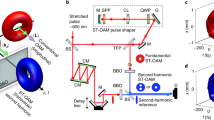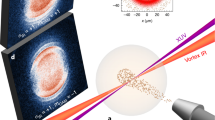Abstract
It has long been thought1 that the inverse Doppler frequency shift of light2,3,4,5,6,7,8,9,10,11,12,13 is impossible in homogeneous systems with a positive refractive index. Here we break this long-held tenet by predicting a previously unconsidered Doppler effect of light inside a radiation cone, the so-called Vavilov–Cherenkov cone, under specific circumstances. It has been known from the classic work of Ginzburg and Frank that a superlight (that is, superluminal) normal Doppler effect14,15,16,17,18 appears inside the Vavilov–Cherenkov cone if the velocity of the source v is larger than the phase velocity of light vp. By further developing their theory, we discover that an inverse Doppler frequency shift will arise if v > 2vp. We denote this as the superlight inverse Doppler effect. Moreover, we show that the superlight inverse Doppler effect can be spatially separated from the other Doppler effects by using highly squeezed polaritons (such as graphene plasmons), which may facilitate the experimental observation.
This is a preview of subscription content, access via your institution
Access options
Access Nature and 54 other Nature Portfolio journals
Get Nature+, our best-value online-access subscription
$29.99 / 30 days
cancel any time
Subscribe to this journal
Receive 12 print issues and online access
$209.00 per year
only $17.42 per issue
Buy this article
- Purchase on Springer Link
- Instant access to full article PDF
Prices may be subject to local taxes which are calculated during checkout




Similar content being viewed by others
References
Gill, T. P. The Doppler Effect: An Introduction to the Theory of the Effect (Logos, London, 1965).
Veselago, V. G. The electrodynamics of substances with simultaneously negative values of ϵ and μ. Sov. Phys. Uspekhi 10, 509–514 (1968).
Leong, K., Lai, A. & Itoh, T. Demonstration of reverse Doppler effect using a left-handed transmission line. Microw. Opt. Technol. Lett. 48, 545–547 (2006).
Chumak, A. V., Dhagat, P., Jander, A., Serga, A. A. & Hillebrands, B. Reverse Doppler effect of magnons with negative group velocity scattered from a moving Bragg grating. Phys. Rev. B 81, 140404 (2010).
Chen, J. et al. Observation of the inverse Doppler effect in negative-index materials at optical frequencies. Nat. Photon. 5, 239–242 (2011).
Lee, S. H., Park, C. M., Seo, Y. M. & Kim, C. K. Reversed Doppler effect in double negative metamaterials. Phys. Rev. B 81, 241102(R) (2010).
Luo, C. Y., Ibanescu, M., Reed, E. J., Johnson, S. G. & Joannopoulos, J. D. Doppler radiation emitted by an oscillating dipole moving inside a photonic band-gap crystal. Phys. Rev. Lett. 96, 043903 (2006).
Liu, W. F., Russell, P. St. J. & Dong, L. Acousto-optic superlattice modulator using a fiber Bragg grating. Opt. Lett. 22, 1515–1517 (1997).
Hu, X. H., Hang, Z. H., Li, J. S., Zi, J. & Chan, C. T. Anomalous Doppler effects in phononic band gaps. Phys. Rev. E 73, 015602 (2006).
Belyantsev, A. M. & Kozyrev, A. B. Reversed Doppler effect under reflection from a shock electromagnetic wave. Tech. Phys. 47, 1477–1480 (2002).
Seddon, N. & Bearpark, T. Observation of the inverse Doppler effect. Science 302, 1537–1540 (2003).
Reed, E. J., Soljacic, M. & Joannopoulos, J. D. Reversed Doppler effect in photonic crystals. Phys. Rev. Lett. 91, 133901 (2003).
Reed, E. J., Soljacic, M., Ibanescu, M. & Joannopoulos, J. D. Comment on “Observation of the inverse Doppler effect”. Science 305, 778b (2004).
Ginzburg, V. L. & Frank, I. M. About Doppler effect at superlight velocity. Dokl. Akad. Nauk SSSR 56, 583–586 (1947).
Frank, I. M. Optics of light sources moving in refractive media. Science 131, 702–712 (1960).
Tamm, I. E. Nobel Lectures, Physics 1942–1962 470–482 (Elsevier, Amsterdam, 1964).
Ginzburg, V. L. Radiation by uniformly moving sources (Vavilov–Cherenkov effect, transition radiation, and other phenomena). Phys.-Usp. 39, 973–982 (1996).
Einat, M. & Jerby, E. Normal and anomalous Doppler effects in a dielectric-loaded stripline cyclotron-resonance maser oscillator. Phys. Rev. E 56, 5996–6001 (1997).
Lin, X. et al. Splashing transients of 2D plasmons launched by swift electrons. Sci. Adv. 3, e1601192 (2017).
Pendry, J. B. Time reversal and negative refraction. Science 322, 71–73 (2008).
Silveirinha, M. G. Quantization of the electromagnetic field in nondispersive polarizable moving media above the Cherenkov threshold. Phys. Rev. A 88, 043846 (2013).
Silveirinha, M. G. Theory of quantum friction. New J. Phys. 16, 063011 (2014).
Silveirinha, M. G. Optical instabilities and spontaneous light emission by polarizable moving matter. Phys. Rev. X 4, 031013 (2014).
Lin, X. et al. All-angle negative refraction of highly squeezed plasmon and phonon polaritons in graphene-boron nitride heterostructures. Proc. Natl Acad. Sci. USA 114, 6717–6721 (2017).
Bliokh, K. Y., Rodríguez-Fortuño, F. J., Nori, F. & Zayats, A. V. Spin–orbit interactions of light. Nat. Photon. 9, 796–808 (2015).
Bakunov, M. I., Tsarev, M. V. & Hangyo, M. Cherenkov emission of terahertz surface plasmon polaritons from a superluminal optical spot on a structured metal surface. Opt. Express 17, 9323–9329 (2009).
Shi, X. et al. Caustic graphene plasmons with Kelvin angle. Phys. Rev. B 92, 081404(R) (2015).
García de Abajo, F. J. & Echenique, P. M. Wake potential in the vicinity of a surface. Phys. Rev. B 46, 2663 (1992).
Philbin, T. G. et al. Fiber-optical analog of the event horizon. Science 319, 1367–1370 (2008).
Bermudez, D. & Leonhardt, U. Hawking spectrum for a fiber-optical analog of the event horizon. Phys. Rev. A 93, 053820 (2016).
Acknowledgements
This work was sponsored by the Singapore Ministry of Education (grant nos. MOE2015-T2-1-070, MOE2016-T3-1-006 and Tier 1 RG174/16 (S)), and the US Army Research Laboratory and the US Army Research Office through the Institute for Soldier Nanotechnologies (contract nos. W911NF-18-2-0048 and W911NF-13-D-0001). I.K. is an Azrieli Fellow, supported by the Azrieli Foundation, and was partially supported by the Seventh Framework Programme of the European Research Council (FP7-Marie Curie IOF) under grant no. 328853-MC-BSiCS.
Author information
Authors and Affiliations
Contributions
All authors contributed extensively to the work presented in this paper. X.L., X.S. and B.Z. conceived the research. X.S. and X.L. performed the calculation. I.K., J.D.J., M.S, F.G., Z.Y. and B.Z. contributed insight and discussion on the results. X.L., X.S., B.Z., I.K., J.D.J. and M.S wrote the paper. B.Z., I.K., J.D.J. and M.S. supervised the project.
Corresponding authors
Ethics declarations
Competing interests
The authors declare no competing interests.
Additional information
Publisher’s note: Springer Nature remains neutral with regard to jurisdictional claims in published maps and institutional affiliations.
Supplementary information
Supplementary Information
Four chapters, two figures, 11 references
Supplementary Video
Duration: 11 s
Rights and permissions
About this article
Cite this article
Shi, X., Lin, X., Kaminer, I. et al. Superlight inverse Doppler effect. Nature Phys 14, 1001–1005 (2018). https://doi.org/10.1038/s41567-018-0209-6
Received:
Accepted:
Published:
Issue Date:
DOI: https://doi.org/10.1038/s41567-018-0209-6
This article is cited by
-
Coherence and superradiance from a plasma-based quasiparticle accelerator
Nature Photonics (2024)
-
Electromagnetic near-field mutual coupling suppression with active Janus sources
Communications Physics (2024)
-
Momentum considerations inside near-zero index materials
Light: Science & Applications (2022)
-
A Brewster route to Cherenkov detectors
Nature Communications (2021)
-
Control of quantum electrodynamical processes by shaping electron wavepackets
Nature Communications (2021)



